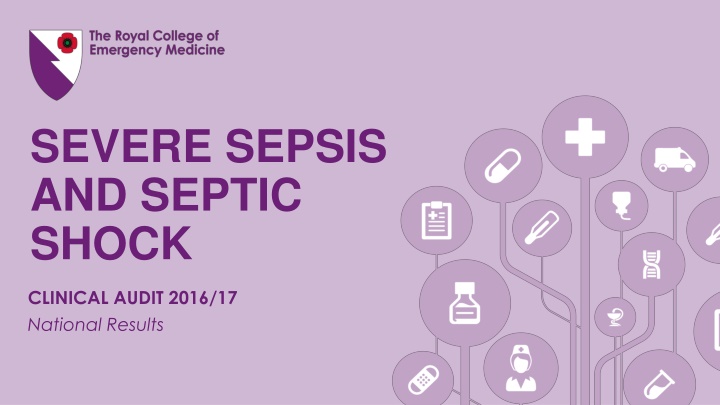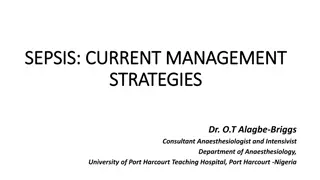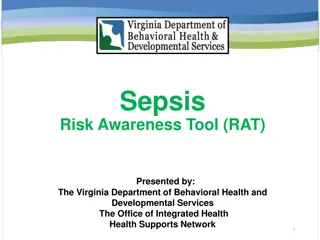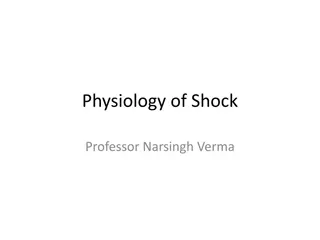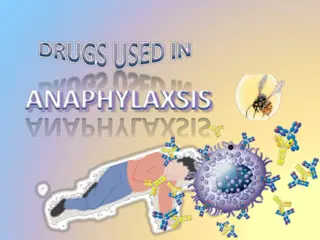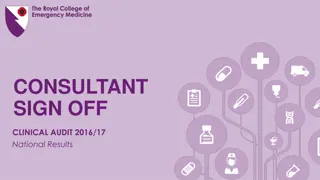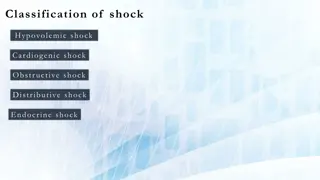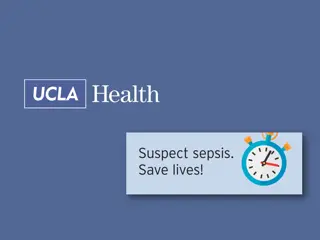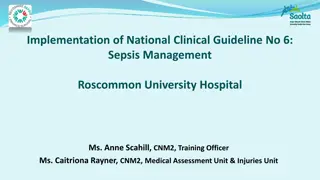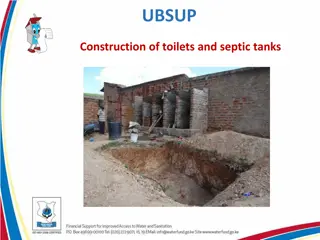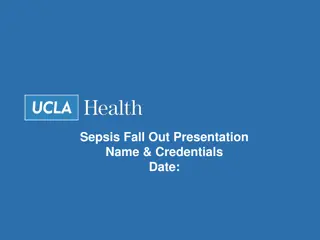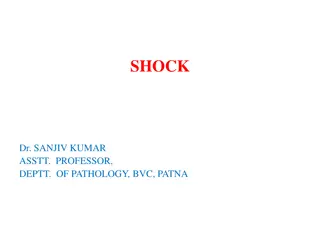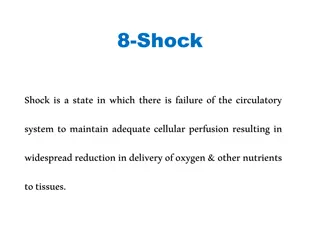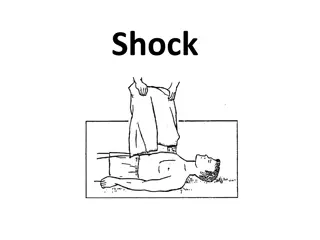National Audit Results for Severe Sepsis and Septic Shock 2016/17
This presentation outlines the national results of a clinical audit conducted in 2016/17 regarding the management of severe sepsis and septic shock in Emergency Departments (EDs). The audit objectives include benchmarking current performance, facilitating national and peer comparisons, identifying areas for improvement, and comparing against previous performance in 2011/12 and 2013/14. Standards evaluated encompass recording vital signs on arrival, senior medical review before discharge, oxygen therapy, lactate measurement, blood cultures, fluid administration, antibiotic timing, and fluid balance monitoring. The executive summary graph indicates national median compliance levels with audit standards. Overall, the audit aims to enhance the quality of care provided to patients with severe sepsis and septic shock.
Download Presentation

Please find below an Image/Link to download the presentation.
The content on the website is provided AS IS for your information and personal use only. It may not be sold, licensed, or shared on other websites without obtaining consent from the author.If you encounter any issues during the download, it is possible that the publisher has removed the file from their server.
You are allowed to download the files provided on this website for personal or commercial use, subject to the condition that they are used lawfully. All files are the property of their respective owners.
The content on the website is provided AS IS for your information and personal use only. It may not be sold, licensed, or shared on other websites without obtaining consent from the author.
E N D
Presentation Transcript
SEVERE SEPSIS AND SEPTIC SHOCK CLINICAL AUDIT 2016/17 National Results
Contents This presentation shows how EDs are performing against the audit standards. For further information please see the national report at www.rcem.ac.uk/audits.
Audit objectives 1. To benchmark current performance in EDs against the standards 2. To allow comparison nationally and between peers 3. To identify areas in need of improvement 4. To compare against previous performance in 2011/12 and 2013/14
Standards Standard Standard type Fundamental 1. Respiratory Rate, Oxygen Saturations (SaO2), Supplemental Oxygen Requirement, Temperature, Blood Pressure, Heart Rate, Level of Consciousness (AVPU or GCS) and Capillary Blood Glucose recorded on arrival Developmental 2. Review by a senior (ST4+ or equivalent) ED medic or involvement of Critical Care medic (including the outreach team or equivalent) before leaving the ED 3. O2was initiated to maintain SaO2>94% (unless there is a documented reason not to): Aspirational a. 50% within one hour of arrival Developmental b. 100% within four hours of arrival 4. Serum Lactate measured within four hours of arrival Aspirational a. 50% within one hour of arrival Developmental b. 100% within four hours of arrival
Standards Standard Standard type 5. Blood Cultures obtained Aspirational a. 50% within one hour of arrival Developmental b. 100% within four hours of arrival 6. Fluids first intravenous crystalloid fluid bolus (up to 30mL/kg) given: Developmental a. 75% within one hour of arrival Fundamental b. 100% within four hours of arrival 7. Antibiotics administered: Developmental a. 50% within one hour of arrival Fundamental b. 100% within four hours of arrival Developmental 8. Urine Output measurement/ Fluid Balance Chart instituted within four hours of arrival
Executive summary This graph shows the median national performance against standards for this audit Higher scores (e.g. 100%) indicate higher compliance with the standards and better performance.
Summary of national findings National Results RCEM Standard 2016/17 (13129 cases) 2013/14 2011/12 Median Median quartile quartile Median Upper Lower STANDARD 1: Respiratory Rate, Oxygen Saturations (SaO2), Supplemental Oxygen Requirement, Temperature, Blood Pressure, Heart Rate, Level of Consciousness (AVPU or GCS) and Capillary Blood Glucose recorded on arrival 100% 50% 69% 91% - - STANDARD 2: Review by a senior (ST4+ or equivalent) ED medic or involvement of Critical Care medic (including the outreach team or equivalent) before leaving the ED 100% 52% 65% 76% - -
Summary of national findings National Results 2016/17 (13129 cases) 2013/14 2011/12 Standard RCEM UQ LQ M M M STANDARD 3: O2 was initiated to maintain SaO2>94% (unless there is a documented reason not to) 50% STANDARD 3a: 50% within one hour of arrival 10% 30% 59% 29% 33% 100% STANDARD 3b: 100% within four hours of arrival 11% 39% 68% - - STANDARD 4: Serum Lactate measured within four hours of arrival 37% 60% 72% 49% 47% STANDARD 4a: 50% within one hour of arrival 50% STANDARD 4b: 100% within four hours of arrival 60% 77% 89% - - 100%
Summary of national findings National Results RCEM Standard 2016/17 (13129 cases) 2013/14 2011/12 UQ LQ M M M STANDARD 5: Blood Cultures obtained STANDARD 5a: 50% within one hour of arrival 50% 25% 45% 62% 40% 32% 100% STANDARD 5b: 100% within four hours of arrival 36% 59% 79% - - STANDARD 6: Fluids first intravenous crystalloid fluid bolus (up to 30mL/kg) given: STANDARD 6a: 75% within one hour of arrival 25% 43% 57% 40% 40% 75% 59% 78% 89% - - 100% STANDARD 6b: 100% within four hours of arrival
Summary of national findings RCEM Standard National Results 2016/17 (13129 cases) 2013/14 2011/12 UQ LQ M M M STANDARD 7: Antibiotics administered: 28% 44% 58% 32% 27% STANDARD 7a: 50% within one hour of arrival 50% STANDARD 7b: 100% within four hours of arrival 70% 83% 91% - - 100% STANDARD 8: Urine Output measurement/ Fluid Balance Chart instituted within four hours of arrival 6% 18% 38% - - 100%
Organisational audit and casemix How do patients attending EDs compare nationally? What organisational features do ED s have? This section helps you understand more about the case mix and demographics of the patients.
Organisational audit This was the first time that organisational data were analysed. Almost all EDs have a sepsis lead, a sepsis protocol and provide sepsis education. This is a great achievement and shows how responsive we are as a specialty to the many recommendations for improved organisation that have come from national reports. Patient information should be the next focus, as currently few EDs provide it. The new (Sepsis-3) definitions were published in early 2016 and less than half of EDs have started to use them.
Patient arrival Sample: all patients The time and day of presentation appears to follows a normal pattern of ED attendances during the day, with no reduction over the weekend and increased attendance on Mondays and Tuesdays.
Audit results How did EDs perform against the standards? This section helps you understand more about how EDs performed nationally.
Audit results vital sign monitoring STANDARD 1: Respiratory Rate, Oxygen Saturations (SaO2), Supplemental Oxygen Requirement, Temperature, Blood Pressure, Heart Rate, Level of Consciousness (AVPU or GCS) and Capillary Blood Glucose recorded on arrival Sample: all patients
Audit results Senior clinician involved in care STANDARD 2: Review by a senior (ST4+ or equivalent) ED medic or involvement of Critical Care medic (including the outreach team or equivalent) before leaving the ED Sample: all patients
Was oxygen initiated to maintain SaO2>94%? O2 was initiated to maintain SaO2>94% (unless there is a documented reason not to) STANDARD 3a: 50% within 1 hour of arrival STANDARD 3b: 100% within 4 hours of arrival Sample: all patients excluding Q7 = no reasons recorded
Was serum lactate measurement obtained prior to leaving the ED? Serum Lactate measured within four hours of arrival STANDARD 4a: 50% within 1 hour of arrival STANDARD 4b: 100% within 4 hours of arrival Sample: all patients excluding Q8 = no reasons recorded
Were blood cultures obtained prior to leaving the ED? Blood cultures obtained STANDARD 5a: 50% within 1 hour of arrival STANDARD 5b: 100% within 4 hours of arrival Sample: all patients excluding Q9 = no reasons recorded
Was the first intravenous crystalloid fluid bolus (up to 30ml/kg) given in the ED? Fluids first intravenous crystalloid bolus (up to 30mL/kg) given STANDARD 6a: 50% within 1 hour of arrival STANDARD 6b: 100% within 4 hours of arrival Sample: all patients excluding Q10 = no reasons recorded
Were antibiotics administered in the ED? Antibiotics administered STANDARD 7a: 50% within 1 hour of arrival STANDARD 7b: 100% within 4 hours of arrival Sample: all patients excluding Q11 = no reasons recorded
Was urine output measurement/ Fluid Balance Chart instituted prior to leaving the ED? STANDARD 8a: Urine Output measurement/ Fluid Balance Chart instituted within four hours of arrival Sample: all patients excluding Q12 = no reasons recorded
Recommendations 1.All EDs should have a sepsis lead and a sepsis protocol 2.RCEM recommends that all sepsis leads consider the following: a) Is everything being done to ensure that a full set of timely observations is performed on every patient? b) Is there a more senior doctor available to review patients with sepsis 24/7? c) Is oxygen considered part of the treatment for sepsis and how is this clearly documented? d) Is lactate measurement possible and simple in your department? e) Does your hospital give clear instructions on which antibiotics should be used? f) Does your protocol encourage urine output monitoring, especially if the patient does not require a catheter?
Recommendations 3. Early recognition of sepsis is critical to the clinical outcome. All patients with suspected sepsis and a NEWS of 3 should undergo immediate screening for sepsis. 4. Patient information should be provided to all patients, and/or relatives, admitted with sepsis. 5. Standardise pathways of care for patients fulfilling sepsis criteria to improve timely delivery of care and therefore outcomes. 6. Education and training around these for wider team for early recognition and instigation of optimal care.
Next steps Read the full report at www.rcem.ac.uk/audits Action planning Rapid cycle quality improvement Contact other EDs for tips & solutions
